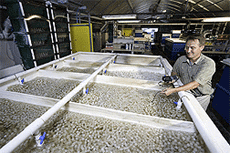
(D1341-10)
Found in the warm waters off the Atlantic and Gulf coasts, these saltwater superstars are prized for both commercial and sport fishing. Pompano (pronounced POM-puh-no) and cobia (COE-bee-uh) have firm, mostly white flesh that’s perfect for grilling, pan-frying, or baking. Some people find that pompano has a pleasing, slightly sweet note.
Pompano is flat and silvery, and looks something like sunfish. Cobia is long and sleek, with a silver stripe on its dark-grey sides. Both of these scrumptious seafarers command premium prices—sometimes as much as $30 a pound filleted.
Someday, pompano, cobia, and other marine finfish might be commonly raised inland, hundreds of miles from the nearest ocean or bay. They’d be reared in huge tanks of water—fresh or slightly salty—in what’s known as a “recirculating aquaculture system” (RAS).
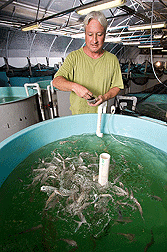
(D1228-11)
These systems, in which water is cleaned and used again and again, are referred to as “closed” because they’re almost completely self-contained. They offer the potential to reduce discharge of everyday fish-farm effluent to as little as 3 percent—or less—of the total amount of water used each day. All the effluent could be treated to make it suitable to apply on land (if it’s freshwater) or to artificial saltwater marshes (if it’s low-salinity wastewater).
The fish waste and unused food collected in the system’s filters could be used as nutrient-rich compost or perhaps for generating methane.
These water-sparing systems present an alternative to coastside flow-through operations that run millions of gallons of seawater into and out of tanks every year. What’s more, RAS-based fish farms could provide an alternative to today’s practice of raising marine fish in net cages or pens in the ocean. RAS production of seafood could diminish unwanted spread of nutrients from feed or fish wastes, reduce risk of diseases being transmitted from domesticated fish to their seagoing brethren or vice versa, and avoid unplanned breeding.
But before these low-salinity farms for seafood can become a reality, much more remains to be discovered about the needs of the saltwater fish that would be reared in them. In addition to figuring out the biological realities of raising these fish, there’s a myriad of engineering details to be worked out. After all, the RAS technology was designed for freshwater—not saltwater—fish farms. For example, some of today’s RAS filtering technology is about 30 percent less efficient in handling seawater than freshwater.
A team of ARS aquaculture researchers in the southeast Florida city of Fort Pierce are tackling all these issues. Fish biologist Chuck Weirich, fish nutritionist Marty Riche, and agricultural engineer Tim Pfeiffer are based at the Harbor Branch Oceanographic Institute. Part of Florida Atlantic University, the institute is one of many organizations with which the team collaborates. The ARS research is managed through the Arkansas-based Harry K. Dupree Stuttgart National Aquaculture Research Center.
Spawning Success
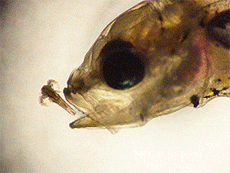
(D1346-1)
To make the systems a commercial and environmental success requires taking a close look at every aspect of the lives of the fish—from spawning by the parents, or broodstock, to the needs of the larvae, or seedstock, that emerge from the tiny eggs, to the requirements of the fingerlings, the juvenile fish that end up as delectable fillets or, in some cases, broodstock.
Every detail—from how to coax broodstock to spawn all year round to how much ammonia and nitrate buildup fingerlings can tolerate in their recirculating tanks—has to be tested. With this new knowledge, growers who invest in the RAS technology should have a better chance of making their new-age fish farms profitable.
In an experiment with 2,400 juvenile pompano, the scientists showed that it’s indeed possible to raise this species in water that’s only slightly salty. In this case, the water had a salinity of only 5 parts per thousand as compared to the 35 parts per thousand in most of the world’s oceans.
The accomplishment is a remarkable scientific first. It provides important proof that the concept of raising saltwater species in nearly fresh water—an alien environment to which the animals are not adapted—can be done for short periods of time. In this case, the pompano that the researchers reared from juveniles to healthy, harvest-ready adults lived in the low-salinity water of the “grow-out tanks,” as they are called, for only 110 days. What remains is to make the system practical, profitable, and energy efficient for not just the grow-out phase but for the broodstock and hatchery phases, as well.
Food, Water, and Room To Grow
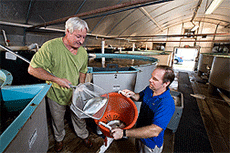
(D1226-34)
What to feed the saltwater fish during the various stages of their captive lives is, of course, one of the most pressing questions. In a study with 50,000 pompano larvae, fish biologist Weirich and colleagues learned more about the feeding habits of these baby fish. For the study, the researchers used digital photography and image-analysis software to observe and record the larvae, which, in their earliest days, are transparent and look something like tadpoles.
The scientists determined the optimum size classes of two kinds of live prey—brine shrimp and tiny organisms called “rotifers.” At various stages of their growth, the little fish are capable of catching and eating these snacks as they swim by. During this growth phase, the upper and lower jaws of the larvae, and their miniature digestive systems, are still developing. The fish are born with their mouths closed, and the size of the opening, or “gape,” that develops determines the size of the food—in their case, rotifers and brine shrimp—that they’re able to nab and swallow.
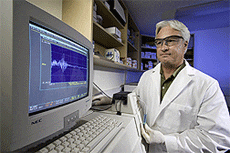
(D1230-5)
In new studies, Weirich and colleague Riche are determining how to wean the larvae off of these live feeds more quickly. That’s because cultivating live feeds for the infant fish is more costly and labor-intensive than simply giving them dry feeds. Those feeds won’t appear on their menu until the fish have made the transition from larvae to juvenile.
Moving juveniles from the nursery tanks to the world of the grow-out tanks—where they’ll develop to market-ready weights—poses the question of how many of these young fish can be put into a tank without overcrowding them.
Overstocking can cause stress and may increase risk of disease, reduce growth rates, and create other problems that can bite into profits. Weirich, Harbor Branch Oceanographic Institute colleague Paul Wills, and Riche found that pompano stocked at the rate of 200 fish per tank weighed about 1.5 pounds at harvest, making them about 10 percent heavier than pompano stocked at a rate of 400 per tank.
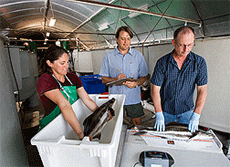
(D1227-2)
But a cobia study by Weirich and Wills showed no significant difference in their survival, or weight at harvest, regardless of whether the fish were stocked at a low (35 fish per tank), medium (70 fish), or high (106 fish) density. At the end of the study, all the cobia weighed about the same. Each yielded two generously sized fillets.
No matter what the stocking rate, finfish won’t flourish in recirculating tanks if there are life-threatening problems with the quality of the water. To keep the recirculating water clean and to limit risk of disease, the researchers are determining the most cost-effective use of what are known as “biofilters.” These devices contain bacteria that convert the toxic ammonia in fish waste into less-toxic forms (nitrite and nitrate). In other work, they’re evaluating alternative methods to efficiently remove solids—such as waste and uneaten feed—from the system.
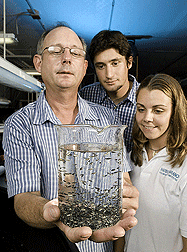
(D1229-5)
Pfeiffer is leading studies of what is known as “airlift technology” to power the system’s water-treatment components. Airlift systems can cut energy costs because they use less electricity than conventional centrifugal pumps for moving water.
There’s an additional twist to the engineering and design research: The water-quality requirements of each species may differ, and what works to keep one species healthy and fast growing might not succeed with another. That means the components, or combinations of components, may have to be customized.
Much remains to be learned about the fish and the recirculating systems. And even when the technology is ready to use, no one can predict how long it will then take before inland farming of seafood—in these recirculating tanks—becomes as common as on-land farming of rainbow trout or catfish. For people living far from the sea, who’d like to be able to buy fresh, locally raised seafood at their neighborhood supermarket, environmentally responsible inland mariculture simply can’t happen soon enough.—By Marcia Wood, Agricultural Research Service Information Staff.
February 2009




